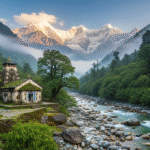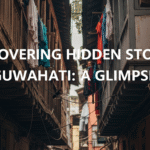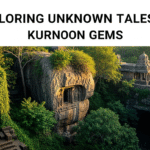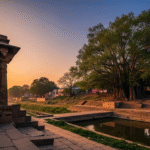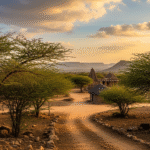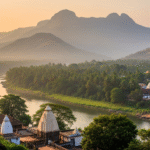Did you know Jaipur, famous for its grand palaces and lively culture, was created by Maharaja Sawai Jai Singh II in the 18th century? This Pink City, with its rich past, is full of unknown stories and secrets. These make it even more charming. It has majestic forts and beautiful buildings that show Rajput and Mughal skill.
Jaipur is close to the Aravali hills and Delhi NCR. But it’s not just known for its bright streets and old places. The city has special stories, myths, and truths waiting to be discovered. Every building, now sometimes a fancy hotel, tells its own tale. This makes visiting Jaipur magical. Learning about its grand history and culture makes people love the city even more.
Key Takeaways:
- Jaipur merges history with contemporary culture, offering a dynamic cultural experience.
- The city’s traditional attire reflects deep cultural roots, with each piece narrating a historical tale.
- Jaipur’s culinary scene blends spicy curries and sweet delights, making it a gastronomic haven.
- Popular landmarks like Amer Fort and Hawa Mahal attract heritage enthusiasts all year round.
- Workshops and cultural events provide immersive experiences into Jaipur’s traditional art forms.
- Jaipur’s art scene features both traditional and contemporary galleries, live music, and dance.
- The City Palace, founded in 1727, showcases Rajput and European architectural styles.
The Historical Gates of Jaipur: Protectors of the Pink City
The Pink City is a marvel in the Golden Triangle tour, with Delhi and Agra. It is surrounded by high walls with eight gates. These gates are not just entry points but also hold many secrets of Jaipur.
The significance of the eight gates
The importance of these gates is huge. They were made to protect the city from attacks and disasters. Now, they stand as symbols of Jaipur’s safety.
At key points, the gates helped in moving goods and defending the city. The Kishan Pol, Ajmeri Gate, and Sanganeri Gate are special. They show great design and tell stories from the past.
Jaipur was planned as a vital trade center by Maharaja Sawai Jai Singh II in the 1700s. Each gate had a purpose and meaning. The Patrika Gate is known as the ninth gate. It uses the number 9 in its design, adding to the city’s mystical charm.
Stories and myths surrounding the gates
The Pink City gates come with many legends. These stories mix truth with the wonder of gods. Locals think divine forces kept Jaipur safe. They say gods like Amer’s Sheela Devi and Sanganer’s Sanga Baba protected the city.
During the 2008 terror attacks, bombs near these gates did not explode. Also, Jaipur survived the 1981 floods magically. People think these events show the divine guardianship of the gates. This mix of history and myths keeps the gates respected by both locals and visitors.
| Gate | Significance |
|---|---|
| Ajmeri Gate | Central market access and defense |
| Sanganeri Gate | Trade routes and spiritual significance |
| Kishan Pol | Route to Amber Fort |
| Patrika Gate | Symbolic ninth gate illuminated with number 9 |
Jaipur’s Royal Family: A Modern-Day Maharaja
The Jaipur royal family is very important to India’s culture. Maharaja Padmanabh Singh is a mix of old and new. He shows how royal life can fit with today’s world.
Maharaja Padmanabh Singh: A royal fashion icon
At 13, Padmanabh Singh became a royal fashion icon. He’s been on many magazine covers. He mixes old and new styles. He lives in the City Palace and shares his life on social media. His fashion sense shows the Jaipur royal family in a new light.
https://www.youtube.com/watch?v=dgvgnbEykA4
The legacy of polo in Jaipur’s royalty
Polo is very important to Jaipur’s royal family. Maharaja Padmanabh Singh loves polo and plays it worldwide. This sport links today’s family to its past. On the field, Singh shows the skills and love for polo that his family has always had.
| Aspect | Details |
|---|---|
| Maharaja’s Age at Crowning | 13 |
| Palatial Residence | City Palace |
| Key Interest | Polo |
| Fashion Influence | Global |
| Social Media Engagement | Active |
The Hidden Treasures of Jaigarh Fort
Jaigarh Fort stands tall on the Aravalli range. It has been important since the 1700s, built by Maharaja Jai Singh II. It was made to protect Amer Palace and the town from enemies. The fort’s long walls are made of red sandstone.
A brief history of Jaigarh Fort
The fort is known for its military past and holds many attractions. It is home to Jaivana, the biggest cannon on wheels. This cannon once shot a ball 35 kilometers. The fort also has a huge water tank. It can hold 6 million gallons of water.
Places like Laxmi Vilas, Lalit Mandir, and Aaram Bagh are found here. There’s also a museum with old war tools. The fort’s foundry has unfinished cannons and cannonballs. This shows its history in war.
Attempts to unearth the hidden treasures
Many have tried to find treasures in Jaigarh Fort. In 1977, Prime Minister Indira Gandhi looked for these treasures. The search’s results are still debated. Some say it was a waste, while others disagree. Yet, the idea of hidden treasures keeps many excited.
The fort’s significance in Rajput history
Jaigarh Fort is key to Rajput history. It was a military site and holds the Kachwaha Dynasty’s history. The fort shows the Rajputs’ skill in architecture and war. Today, visitors can see the fort’s history. They also enjoy views of the valleys, including Sagar Lake and Amer town.
The Mystery Behind Jaipur’s Pink Color
Jaipur is known for its pink buildings. This color makes the city look magical. The “Pink City” draws people in, making them wonder about its color choice. The color pink was picked for a royal welcome in 1876. It was for the Prince of Wales and Queen Victoria. This choice shows the city’s warmth and welcoming spirit.

The city’s pink tradition started with that royal visit. It has continued ever since. Now, all old city buildings must be pink. This rule keeps Jaipur’s charm and history alive.
But there’s more to Jaipur than its pink color. Take the Amber Palace at its hilltop spot. It’s a UNESCO site with amazing views. And don’t forget the Hawa Mahal. Its design is a part of Jaipur’s rich history in architecture.
Below is a table listing some of Jaipur’s architectural wonders:
| Landmark | Description | Significance |
|---|---|---|
| Amber Palace | A hilltop palace with breathtaking views | UNESCO Heritage Site |
| Hawa Mahal | Palace of Winds with 953 small windows | Iconic pink sandstone facade |
| Jaipur City Palace | A sprawling complex of palaces | Rich cultural heritage and Rajput architecture |
| Jantar Mantar | 18th-century astronomical observatory | World’s largest stone sundial |
| Jal Mahal | Water palace in Man Sagar Lake | Stunning architectural sight |
These landmarks make Jaipur a must-see place. They add to its visual and historical wealth. The city’s pink color story continues to charm visitors.
First Planned City of India: Jaipur or Chandigarh?
People often argue about India’s first planned city: Jaipur or Chandigarh. Some don’t know Jaipur’s role as the first urban landscape in India.
The Meticulous Planning of Jaipur
Many think Chandigarh was first, but Jaipur holds the title. It was founded in 1727 by Maharaja Sawai Jai Singh II. A smart architect named Vidyadhar Bhattacharya designed it.
The city had neat streets and areas. It was way ahead of its time. People still admire Jaipur’s smart planning today.
The Influence of Vastu Shastra and Shilpa Shastra
Jaipur’s layout was also shaped by Vastu Shastra. Vidyadhar Bhattacharya used this ancient wisdom. He also followed Shilpa Shastra rules.
Together, these made Jaipur’s grid system very precise. It helped the city grow nicely and kept energy flowing well. This mix of old and new ideas makes Jaipur stand out.
Let’s compare Jaipur and Chandigarh to understand this better:
| Aspect | Jaipur | Chandigarh |
|---|---|---|
| Founding Year | 1727 | 1953 |
| Main Architect | Vidyadhar Bhattacharya | Le Corbusier |
| Planning Principles | Vastu Shastra, Shilpa Shastra | European Modernism |
| Architectural Features | Hawa Mahal, City Palace | Capitol Complex, Rock Garden |
This shows how Jaipur was ahead in urban planning. It set a high standard with Vastu Shastra and smart design. Jaipur is key to the debate about the first planned city.
Lesser-Known Palaces in and around Jaipur
Jaipur has more than just famous spots like Hawa Mahal and Amer Fort. It hides other beautiful palaces worth seeing. These places are full of history and culture. Yet, many still need to discover them.
Exploring Chomu Palace, Shahpura Palace, and others
Chomu Palace, Shahpura Palace, and Samode Palace are truly special. Visiting Chomu Palace is like stepping back in time to see Rajput royalty. Shahpura Palace shows royal luxury and culture. Samode Palace also shares Jaipur’s grand royal history.
Their significance and historical importance
These palaces are more than just pretty buildings. They tell stories of history and culture. They remind us of Jaipur’s rich past. Places like Chomu and Shahpura Palace are key to understanding this legacy. Now, they are fancy hotels letting visitors live like royalty while they explore these lesser-known palaces.
The Jaipur Literature Festival: A Cultural Extravaganza
The Jaipur Literature Festival started in 2006. Namita Gokhale, William Dalrymple, and Sanjoy K. Roy created it. It’s now a big deal worldwide. Known as the world’s largest free literary festival, it attracts thousands from everywhere.
Each year, Jaipur turns into a hub of culture during JLF. It mixes literature with music, art, and food. The festival welcomes big names. Think Salman Rushdie, Arundhati Roy, and many others. Visitors enjoy discussions, music, dance, art, and films.
The festival celebrates cultural diversity all year. It has workshops and outreach programs. The book bazaar has all sorts of books for everyone.
There are sessions and workshops at the festival. Authors and experts lead them. They help new writers learn. Guests can also see unique jewelry, merchandise, and art.
The food at JLF is famous. It takes you on a taste journey of India. The festival has won many awards. It shows how important it is for literature and culture.
| Year | Significant Milestones |
|---|---|
| 2006 | Inaugural JLF with 18 writers and around 100 visitors |
| 2008 | Featured authors like Ian McEwan and Donna Tartt, attendance of around 2,500 |
| 2012 | One of the largest literary events globally, attracting over 75,000 visitors |
| 2024 | Expected to surpass previous editions with an expanded lineup of speakers and cultural offerings |
Each year, JLF draws more people with its mix of ideas and creativity. The 2024 edition will be bigger and better. It will make Jaipur a top cultural place. This festival is important for those who love books and culture.
Jawahar Circle: Asia’s Largest Circular Park
Jawahar Circle is a big win for Jaipur. It focuses on green spaces. It is Jaipur’s largest circular park. It is also among the biggest in Asia. This place is beautiful and useful. It attracts locals and tourists.

The design and layout of Jawahar Circle
The design of Jawahar Circle mixes modern and old styles. It has a big size. The park has paths, green lawns, and lots of plants. These make it great for walks away from the city noise.
The layout lets people enjoy different activities easily. People can jog or kids can play on modern equipment.
The Patrika Gate and its architectural influence
The Patrika Gate is the entrance to Jawahar Circle. It is very Patrika Gate significance stunning. This gate’s design was inspired by Jaipur’s famous Hawa Mahal. It has bright colors and detailed designs. It shows Jaipur’s rich art history.
Patrika Gate is a symbol of culture. It shows Rajasthan’s fancy architecture. It makes a beautiful place for pictures.
The nightly musical fountain show
One special thing at Jawahar Circle is the musical fountain attractions night show. When the sun sets, the park lights up with music and lights. The water and lights dance to music. It looks very beautiful. This show brings together old and new Jaipur. It’s really magical.
In all, Jawahar Circle shows how much Jaipur values design and culture. It’s a great spot for anyone visiting the city. You should see it.
Intriguing Details about Galtaji: The Monkey Temple
Galtaji Monkey Temple is nestled amid the Aravalli hills, close to Jaipur’s heart. It draws millions every year, combining spirituality and nature. Emperor Akbar established it, giving 2592 bighas for its creation in the Mughal era.
The temple showcases Rajputana and Mughal architectural styles. This reflects Jaipur’s rich history.
The complex is open from 5 am to 6 pm without charge. Guests can explore sacred spots like the Krishna Temple and the Shri Sitaramji Temple. There’s also a temple for Rishi Galav.
The Galta Kund, a holy water tank, is fed by springs. It’s vital for pilgrim rituals. This makes Galtaji a beloved spot.
The temple is home to many Rhesus Macaque monkeys. This has earned it the nickname, the Monkey Temple. Sometimes, you can also see Gray Langurs here.
Tourists can take guided tours. They get to interact with the monkeys. Yet, it’s important to be careful.
Galtaji is vibrant during Makar Sakranti on January 14th. It’s filled with colorful festivities. From October to March, the weather is cooler. This makes it a great time for visiting.
Visiting gives you spiritual growth and a chance to try local food. For instance, you can enjoy vegetarian Vaishnav thalis near the complex.
For a deep travel experience, learn more about Galtaji Monkey Temple’s history here. It will enrich your trip to Jaipur’s unique temples.
Conclusion
As we end our journey in Jaipur, we see its deep history. It was founded in 1727 by Maharaja Jai Singh II. Jaipur is the biggest city in Rajasthan, covering 467 km². It’s known for its rich history, not just in buildings but as a living story of culture.
Jaipur is also called the Pink City. It was planned based on old Shilpa Shastra rules. From strong gates to the royal family’s influence today, it’s fascinating. The city turned pink in 1876 for the Prince of Wales. Now, it’s a famous spot worldwide.
In 2019, Jaipur became a UNESCO World Heritage Site. Its GDP shows growth and history together. With over 3 million people and 84.34% can read, it’s inviting. You can explore Jaigarh Fort or enjoy the Jaipur Literature Festival. Jaipur keeps sharing its stories as a cultural hub.
FAQ
What are some unknown facts about Jaipur’s heritage?
Jaipur isn’t just famous for its bright streets and old sites. It’s a city full of unique stories, myths, and facts. People love its heritage and tales, making them adore the Pink City even more.
What is the significance of the eight gates of Jaipur?
Jaipur’s eight gates were very important for protection. They helped keep the city safe from attacks and disasters. Legends say Jaipur was protected by divine beings, adding to its mystical past.
Are there any stories or myths associated with Jaipur’s gates?
Yes, local stories say royal power and gods kept the city safe. Events like the 1981 floods and the 2008 terror attacks didn’t harm Jaipur because of this protection.
Who is Maharaja Padmanabh Singh and what is his modern-day role?
Maharaja Padmanabh Singh became king at 13. He connects with people online and is seen in fashion magazines. His love for polo shows the lasting charm of Jaipur’s royal culture.
How has polo featured in Jaipur’s royal tradition?
Polo has a special place in Jaipur’s royal history. Maharaja Padmanabh’s interest in it shows the sport’s lasting importance. It keeps the city’s noble spirit alive today.
Can you share some historical information about Jaigarh Fort?
Jaigarh Fort is a key piece of Rajput history. It tells stories of Jaipur’s royal past. No one has found its hidden treasures, making the fort even more mysterious.
What attempts have been made to unearth Jaigarh Fort’s hidden treasures?
Reports say Prime Minister Indira Gandhi searched for the fort’s treasures. But, they remained hidden despite her efforts during the Emergency.
What is the story behind Jaipur’s pink color?
Jaipur turned pink to welcome the Prince of Wales and Queen Victoria in 1876. This pink tradition shows Jaipur’s warm welcome and has lasted since Maharaja Ram Singh’s time.
How is Jaipur considered India’s first planned city?
Maharaja Sawai Jai Singh II designed Jaipur in 1727. Its design, based on Vastu Shastra and Shilpa Shastra, made it India’s first planned city. Its orderly layout is still admired.
What are some lesser-known palaces in and around Jaipur?
Places like Chomu Palace, Shahpura Palace, and Samode Palace are less known. These palaces tell stories of Jaipur’s rich past. They also welcome visitors as luxury hotels today.
What makes the Jaipur Literature Festival a cultural phenomenon?
Started in 2006, the Jaipur Literature Festival is the world’s biggest free literary event. It draws book lovers, writers, and artists worldwide, turning Jaipur into a cultural hub. This festival gives many reasons to explore Jaipur.
What is special about Jawahar Circle?
Jawahar Circle is the biggest circular park in Asia. It has beautiful gardens, paths, and a colorful fountain show every night. It blends culture and nature, adding charm to Jaipur.
Why is Galtaji known as the Monkey Temple?
Galtaji is famous for its monkeys and beautiful hillside location. This sacred place has pools filled by a spring. It offers peace and fun, making it a unique spot.


